
The Battle of Villers-Bocage took place during the Second World War on 13 June 1944, one week after the Normandy landings, which had begun the Western Allies' conquest of German-occupied France. The battle was the result of a British attempt to exploit a gap in the German defences west of the city of Caen. After one day of fighting in and around the small town of Villers-Bocage and a second day defending a position outside the town, the British force retreated.
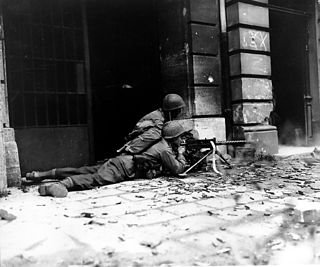
The Battle of Aachen was a battle of World War II, fought by American and German forces in and around Aachen, Germany, between 12 September and 21 October 1944. The city had been incorporated into the Siegfried Line, the main defensive network on Germany's western border; the Allies had hoped to capture it quickly and advance into the industrialized Ruhr Basin. Although most of Aachen's civilian population was evacuated before the battle began, much of the city was destroyed and both sides suffered heavy losses.
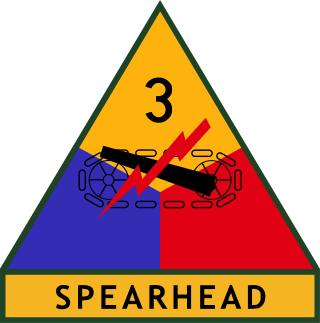
The 3rd Armored Division was an armored division of the United States Army. Unofficially nicknamed the "Third Herd", the division was first activated in 1941 and was active in the European Theater of World War II. The division was stationed in West Germany for much of the Cold War and also participated in the Persian Gulf War. On 17 January 1992, still in Germany, the division ceased operations. In October 1992, it was formally inactivated as part of a general drawing down of U.S. military forces at the end of the Cold War.

The Guards Armoured Division was an armoured division of the British Army during the Second World War. The division was created in the United Kingdom on 17 June 1941 during the Second World War from elements of the Guards units, the Grenadier Guards, Coldstream Guards, Scots Guards, Irish Guards, Welsh Guards, and the Household Cavalry.

The 8th Armored Division was an armored division of the United States Army that served in the European Theater of World War II.

The 10th Armored Division was an armored division of the United States Army in World War II. In the European Theater of Operations the 10th Armored Division was part of both the Twelfth United States Army Group and Sixth United States Army Group. Originally assigned to the Third United States Army under General George S. Patton, it saw action with the Seventh United States Army under General Alexander Patch near the conclusion of the war.

The 11th Armored Division was a division of the United States Army in World War II. It was activated on 15 August 1942 at Camp Polk, Louisiana and moved on 24 June 1943 for the Louisiana Maneuvers. Transferred then to Camp Barkeley, Texas on 5 September 1943, the division participated, beginning 29 October 1943, in the California Maneuvers and arrived at Camp Cooke California on 11 February 1944. The division staged at Camp Kilmer, New Jersey from 16 to 29 September 1944 until departing New York Port of Embarkation on 29 September 1944, arriving in England on 11 October 1944.

The 20th Armored Division was an armored division of the United States Army that fought in World War II. It was activated on 15 March 1943 at Camp Campbell in Kentucky.

The Fulda Gap, an area between the Hesse-Thuringian border, the former Inner German border, and Frankfurt am Main, contains two corridors of lowlands through which tanks might have driven in a surprise attack by the Soviets and their Warsaw Pact allies to gain crossings of the Rhine River. Named for the town of Fulda, the Fulda Gap became seen as strategically important during the Cold War of 1947–1991. The Fulda Gap roughly corresponds to the route along which Napoleon chose to withdraw his armies after defeat at the Battle of Leipzig. Napoleon succeeded in defeating a Bavarian-Austrian army under Wrede in the Battle of Hanau not far from Frankfurt. From there he escaped back to France.
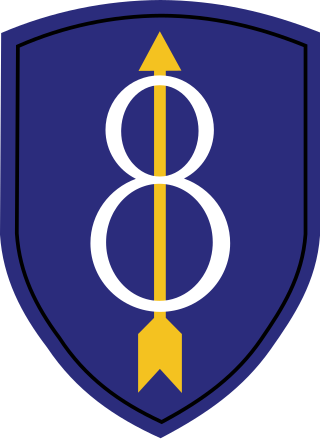
The 8th Infantry Division, ("Pathfinder") was an infantry division of the United States Army during the 20th century. The division served in World War I, World War II, and Operation Desert Storm. Initially activated in January 1918, the unit did not see combat during World War I and returned to the United States. Some units would serve in the American Expeditionary Force to Siberia. Activated again on 1 July 1940 as part of the build-up of military forces prior to the United States' entry into World War II, the division saw extensive action in the European Theatre of Operations. Following World War II, the division was moved to West Germany, where it remained stationed at the Rose Barracks in Bad Kreuznach until it was inactivated on 17 January 1992.

The 80th Training Command is a formation of the United States Army Reserve.
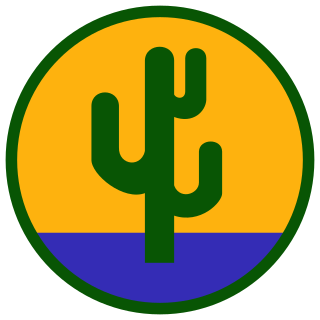
The 103rd Infantry Division was a unit of the United States Army that served in the U.S. Seventh Army of the 6th Army Group during World War II.

The Battle of Nancy in September 1944 was a 10-day battle on the Western Front of World War II in which the Third United States Army defeated German forces defending the approaches to Nancy, France and crossings over the Moselle River to the north and south of the city. The battle resulted in U.S. forces fighting their way across the Moselle and liberating Nancy.
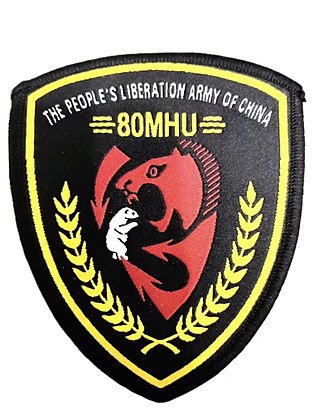
The 80th Medium Combined Arms Brigade, formerly the 80th Division, is a military formation of the People's Liberation Army Ground Force. It's now a maneuver part of the PLA 82nd Group Army.

The 9th Infantry Division Pasubio was an infantry division of the Royal Italian Army during World War II. The Pasubio was classified as an auto-transportable division, meaning it had some motorized transport, but not enough to move the entire division at once. The division was formed as an infantry division in 1934, reorganized as auto-transportable division in 1939 and mobilized in August 1940. It was named for the battles on Pasubio during World War I. Its 79th Infantry Regiment and 8th Artillery Regiment were made up of men from Verona, while the ranks of the 80th Regiment were filled with men from Mantua. Its I CC.NN. Battalion "Sabauda" was made up of Blackshirt volunteers from Turin.

The 44th Infantry Division "Cremona" was an infantry division of the Royal Italian Army during World War II. The Cremona was formed on 24 August 1939 by splitting the 20th Infantry Division "Curtatone and Montanara" into the 20th Infantry Division "Friuli" and 44th Infantry Division "Cremona". The division was named for the city of Cremona. The division served as occupation force on Corsica and fought German units after the Armistice of Cassibile was announced on 8 September 1943. The division then served with the Italian Co-belligerent Army and remained active until the 1975 Italian Army reform.

The Battle of Heilbronn was a nine-day battle in April 1945 during World War II between the United States Army and the German Army for the control of Heilbronn, a mid-sized city on the Neckar River located between Stuttgart and Heidelberg. Despite the impending end of World War II in Europe, the battle was characterized by very firm German resistance and the presence of various Nazi Party auxiliaries among the regular German troops. Following days of house-to-house combat, troops of the U.S. 100th Infantry Division captured Heilbronn and the U.S. VI Corps continued its march to the southeast.
The 318th Rifle Division began forming on June 15, 1942, in and near Novorossiysk on the coast of the Black Sea, as a standard Red Army rifle division; it was later re-formed as a mountain rifle division, but exactly when this happened is disputed among the various sources. It fought in the area it was formed in until September 1943, and was granted the name of this city as an honorific. In November of that year it took part in the largest Soviet amphibious operation of the war, across the Kerch Straits into the easternmost part of the Crimea, but its small beachhead was eliminated some weeks later. After the Crimea was liberated in May 1944, it remained there for several months before it was transferred to the Carpathian Mountains west of Ukraine as a mountain division, and spent the remainder of the war fighting through Czechoslovakia in the direction of Prague. The division continued to serve postwar in this same role, but was converted back to a standard rifle division before it was disbanded in the early 1950s.
The 73rd Guards Rifle Division was reformed as an elite infantry division of the Red Army in March 1943, based on the 2nd formation of the 38th Rifle Division, and served in that role until after the end of the Great Patriotic War.
The 78th Guards Rifle Division was reformed as an elite infantry division of the Red Army in March 1943, based on the 1st formation of the 204th Rifle Division, and served in that role until after the end of the Great Patriotic War.

















